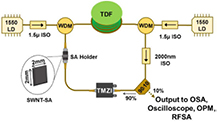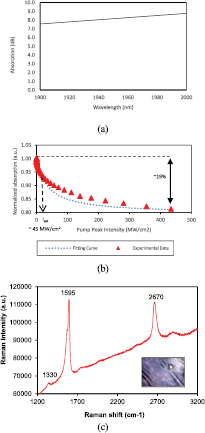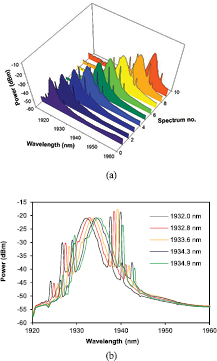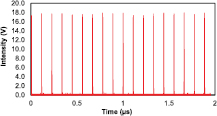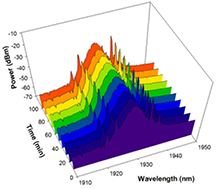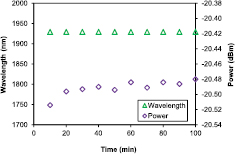Abstract
An ultrafast thulium-doped fiber laser (TDFL) with a wavelength tunable, passive mode-locked output is proposed and demonstrated. The TDFL employs a tunable Mach–Zehnder interferometer (TMZI) and a single-wall carbon nanotube (SWCNT)-based saturable absorber (SA). The TMZI provides the TDFL with a tuning range of almost 30.0 mm from 1919.4 to 1949.2 nm while at the same time maintaining the soliton output, with wavelength shifts of as small as 0.6 nm. The TDFL generates mode-locked pulses at a pump power of above 146.4 mW, and has a repetition rate of 9.1 MHz with an average minimum pulse width of 1.68 ps, as well as a maximum pulse energy and peak power value of 24.3 pJ and 13.0 W respectively. The mode-locked pulse is highly stable and has a relatively high signal-to-noise ratio value of around 56.0 dB. The use of the SWCNT-based SA is essential in generating the mode-locked pulses and the proposed laser has many potential uses in sensing and spectroscopy as well as in the generation of intense light sources for nonlinear optical applications.
Export citation and abstract BibTeX RIS
1. Introduction
Two-micron wavelength fiber lasers have recently become the focus of increasing research interest due to their ability to generate a lasing output with a high absorption coefficient in water and gases, making them high-potential candidates for sensing applications [1] compared to other used near- and mid-infrared wavelengths [2]. Furthermore, two-micron lasers are also 'eye-safe', sparking substantial interest for employment in industrial use, precision medical applications [2, 3], sensing [4–7] and spectroscopy [8–10].
In order to achieve the desired output, research has shown that the thulium-doped fiber (TDF) is an excellent candidate for generating an efficient two-micron wavelength laser output in a relatively compact platform. Compared to other rare-earth doped fibers, the TDF performs better in terms of its slope efficiency as it can overcome the Stokes limit [11, 12] and also has a high quantum efficiency of almost 200% due to the intrinsic property of Tm3+ ions transferring energy from the 3H6 and 3H4 levels to the 3F4 level by cross-relaxation [13]. The TDF is also a prime choice in the development of tunable lasers as a result of its wide amplified spontaneous emission (ASE) spectrum from 1700 to 2100 nm. Furthermore, passively mode-locked TDF lasers (TDFLs) are of particular interest [14–17] due to their significant applications in high-speed spectroscopy, sensing and biomedical research [1, 6, 8, 18].
Graphene has been seen as a highly suitable candidate for passive mode-locking due to its broadband saturable absorption characteristics which cover most of the visible to microwave region [19]. Furthermore, many new materials have also been synthesized and tested for usage as SAs to produce stable mode-locked pulses. These include transition metal dichalcogenides (TMDs) such as molybdenum disulfide (MoS2) [20] and tungsten disulfide (WS2) [21], both of which have proven to be highly desirable alternatives for passive mode-locking operations. Topological insulators (TI) [22] and black phosphorus [23] have also shown high promise for application in generating passively mode-locked pulses. However, it is another derivative of carbon that has become the focal point for generating mode-locked pulses in this work, namely single-walled carbon nanotubes (SWCNTs). SWCNTs have a fast recovery time and broad saturable absorption, and have already been proven to be a reliable SA when it comes to mode-locking applications [24]. The capability of the passively mode-locked TDFL can be further expanded by providing it with the ability to tune its mode-locked wavelength, allowing these lasers to be used as seed lasers that exploit optical nonlinearity in fibers to generate intense pulses of light that can be used to obtain Brillouin wavelength combs [19] and even supercontinuum outputs [20–22]. For example, the work performed by Kubat et al [23] demonstrated the potential for thulium-based laser seed to generate a wide-spanning supercontinuum source reaching up to three octaves in the mid-infrared region. Of particular concern would be the need to match the center wavelength of the seed laser with the zero-dispersion wavelength of the nonlinear medium for optimal supercontinuum generation. Furthermore, the tuning capability of the laser can also help to satisfy the phase-matching requirement for second-harmonic generation [24].
Tunable mode-locked TDFLs can be produced by multiple configurations, most easily by simply incorporating grating-based filters to the cavity, such as a tunable bandpass filter (TBF) [25, 26] and arrayed waveguide grating (AWG) [27]. However, grating filters typically have limited bandwidths and suppress the soliton mode-locking regime by eliminating the Kelly sidebands because of the filter device's limiting factor [25, 28, 29] and subsequently expanding the pulse width. Tunable mode-locked TDFLs can also be created by bending and stretching multimode filters [30] and fiber tapers [31]. Despite this, these approaches are crude in nature and cannot be reliably used for critical and well-defined sensing applications that would require precision and repeatability. Recent works have also shown that a wideband tuning range can be realized by manipulating the polarization state of the light propagating in the cavity [25, 32–35], although these systems are also limited in performance as they are polarization-sensitive and thus susceptible to wavelength instability. In order to be used in practical, real-world applications, the entire setup must be rugged and maintain its performance while at the same time being cost-efficient. In this regard, a filter that provides a stable and wide tuning range while maintaining the soliton spectrum of the mode-locked pulses is crucial, and the tunable Mach–Zehnder interferometer (TMZI) is a highly suitable candidate for this task. Currently, it is to the best knowledge of the authors that there are no reports of TMZIs being employed as a wavelength selection mechanism for mode-locked TDFLs, thus prompting the interest of this work to investigate and evaluate a proposed tunable mode-locked TDFL using a TMZI and operating in the two-micron region.
This work proposes and demonstrates a passively mode-locked TDFL with a tunable wavelength output. A SWCNT-based SA is used as the pulse generation mechanism, and is a highly crucial component of the TDFL as it allows a short laser cavity to be realized, which is essential for the generation of mode-locked pulses. The proposed TDFL would be able to act as a compact and cost-effective, yet rugged, mode-locked pulse source for multiple key real-world applications.
2. Experimental setup
Figure 1 shows the schematic of the proposed passively mode-locked TDFL. The TDFL employs a bi-directional pumping scheme, with two Princeton Lightwave model PSL-450 laser diodes (LDs) powering the laser cavity. Both have a central operating wavelength of 1550 nm, with a maximum power output of 228.5 mW each. The bi-directional pumping scheme is employed to prevent the end-part of the thulium-doped fiber (TDF) from reabsorbing the gain imparted by the TDF at the beginning, thus ensuring a high gain and low noise figure [36, 37]. The scheme also allows for a broader ASE spectrum to be obtained, giving a wider tuning range [38]. Each LD is protected by a 1.55-micron optical isolator (ISO) to prevent back-reflections from the laser cavity, and each isolator, in turn, is connected to the cavity through the 2000 nm port of a 1550/2000 division multiplexer (WDM). For both WDMs, the common port is connected to the TDF.
Figure 1. Schematic diagram of the TDFL ring cavity.
Download figure:
Standard image High-resolution imageThe TDF itself is a 4 m long doped fiber obtained from the company OFS, with a core diameter of 5 µm and an absorption coefficient of ~20 dBm−1 at 1550 nm. An ISO optimized for operation at 2000 nm is placed at the 2000 nm port of the WDM connected to the backward pumping LD, thus making signal propagation in the cavity unidirectional. The output of the ISO is connected to a 90:10 tap coupler, which extracts about 10% of the signal for further analysis, and returning 90% of the signal into the cavity. The 90% port connects to the TMZI that is provided by Photonics Technologies. The TMZI is a fiber pigtailed free-space interferometer, consisting of mirrors and beam splitters enclosed in a small and rugged device. The free-space optical design has a clear advantage over all-fiber interferometers which are commonly associated with high sensitivity to polarization variation that may compromise the stability of the laser output. The device has adjustable knobs to change the phase difference between the two interferometer arms which is used to control both the extinction ratio and the free spectral range, thus acting as the wavelength tuning element. The TMZI has a maximum extinction ratio of ~30 dB and insertion loss of about 1.2 dB, along with a tuning range of 38.4 nm, starting from a dip at 1907.06 to 1945.50 nm as given in figure 2. The filtered signal from the TMZI now encounters the SA, which passively generates the pulsed output. The SA is based on an SWCNT thin film using a polyvinyl alcohol (PVA) based substrate in which the SWCNT is homogenously distributed.
Figure 2. Wavelength tunability of the TMZI at maximum extinction ratio.
Download figure:
Standard image High-resolution imageThe SA has a linear optical absorption coefficient of 7.7 dB at a wavelength of 1900 nm to about 8.5 dB at 2000 nm. The SA also has a modulation depth and saturation intensity of 19% and 45 MW cm−2 respectively. These values are illustrated in figures 3(a) and (b). Additionally, Raman spectroscopy of the SWCNTs used for this work reveal three main peaks at 1330, 1595 and 2670 cm−1, as shown in figure 3(c). This corresponds to the tangential G-, D and G' bands, and confirms the presence of SWCNTs within the sample [45]. The G-band arises from the graphite-like structure of the SWCNTs in the 2D plane mode, while the D- and G' bands indicate the disorder induced and dispersive behavior of the SWCNT nanostructures. The inset of figure 3 shows the microscopic image of the SWCNT sample used for the Raman spectroscopy. The complete SA assembly is formed by simply sandwiching a small, 2 mm by 2 mm piece of the SWCNT film in between two fiber ferrules, thus allowing it to be incorporated into the laser cavity.
Figure 3. (a) Linear absorption characteristics of the SWCNT, (b) SWCNT modulation depth and saturation intensity and (c) Raman spectrum of the SWCNT film. The inset shows the microscopic image of the examined Raman spot.
Download figure:
Standard image High-resolution imageThe signal extracted from the cavity, which approximates 10% of the total power, is used to analyze the optical and pulse characteristics of the generated laser output. A Thorlabs S302C optical power meter, which has a resolution of 1.0 µW, is used to provide optical power measurements, while a Yokogawa AQ6375 optical spectrum analyzer with a resolution of 0.05 nm is used to capture the optical spectrum of the generated laser output. The pulse characteristics of the output are analyzed using a Newport 818-BB-51F 12.5 GHz InGaAs based photodetector, connected to a Yokogawa DLM205 oscilloscope (OSC) for measurements in the time domain, and an Anritsu MS2683A radio-frequency spectrum analyzer (RFSA) with a bandwidth of 9 kHz to 7.8 GHz for measurements in the frequency domain. The aforementioned equipment is interchanged as necessary for each measurement.
3. Results and discussion
The laser has a lasing threshold of 58.5 mW, and a mode-locking threshold of 146.4 mW. At this power, a stable, wide-band spectrum is obtained with a 3 dB bandwidth of 2.1 nm as shown in figure 4. Kelly's sidebands are also visible in the spectrum, indicating that the laser is now operating as a soliton mode-locked laser. The optical soliton shows the generation of small sub-sidebands alongside the Kelly sidebands, which is attributed to four-wave-mixing-induced energy exchanges between the differently polarized components in the fiber laser [46].
Figure 4. TDFL soliton mode-locked spectrum output.
Download figure:
Standard image High-resolution imageAdjusting the TMZI allows the center wavelength of the output pulses to be tuned. Tuning is done primarily by adjusting the wavelength control of the TMZI, and balanced by adjusting the extinction-ratio control on the device. Figure 5(a) shows the optical spectrum obtained for different central wavelengths across the entire tuning range of the TMZI. The center wavelength is initially set to 1919.4 nm, which is the lowest tunable wavelength of the TMZI, and increased slowly by 3.0 nm over the entire 30.0 nm tuning range of the TMZI to a final wavelength of 1949.2 nm. It can be seen that the soliton pulses maintain their well-defined shape over the entire tuning range, thus allowing the proposed laser to provide a consistent output over the 30 nm range. In comparison, other works [25–27] report that the Kelly sidebands are absent from the optical spectrum if grating-based tunable filters are used. This is attributed to the filter spectral limit, and is a highly undesirable trait as the suppression of the Kelly sidebands expands the pulse width of the mode-locked laser source. Furthermore, it is also possible to tune the mode-locked spectrum at the sub-nanometer wavelength scale, in steps as small as 0.6 nm. Figure 5(b) shows the spectrum obtained under sub-nanometer wavelength tuning, with average steps of about 1.0 nm. In the same manner as tuning at larger spacing intervals, sub-nanometer tuning of the wavelength also preserves the Kelly sidebands, thus maintaining mode-locked operation in the laser.
Figure 5. (a) 3D plot of the optical spectrum over the full tuning range and (b) sub-nanometer tuning spectrum of the output pulses.
Download figure:
Standard image High-resolution imageThe tuning range of the mode-locked laser is comparable to several tunable mode-locked TDFLs whereby the achievable tunable range is around 20–50 nm [31, 33–35]. Meanwhile, other techniques that require mechanical manipulation of the fiber to induce the wavelength shifts do show wideband tunability [30, 39]. However, pulling or bending the fibers can become unreliable as a precise tuning mechanism, and can be subjected to breakage. On the other hand, the polarization-based wavelength tuning mechanism also exhibits wideband tuning [32, 34, 38], but the stability of the laser to be employed as a practical device will be an issue. The highlight of this work is the versatility of the tunable laser, allowing a large tuning range with sub-nanometer wavelength control, which is novel. The proposed laser provides a rugged tuning mechanism that has a good maximum tunability range with a small resolution.
Since in this setup an autocorrelator operating at two-micron is not available in the laboratory, the pulse width is deduced using the time-bandwidth product (TBP) equation [40], which is given as:

where  is the pulse width in ps,
is the pulse width in ps,  is the bandwidth of the pulse in nm,
is the bandwidth of the pulse in nm,  is the speed of light and
is the speed of light and  is the peak wavelength in nm. Using this equation, and assuming the minimum TBP value for the sech2 curve-fitting of 0.315, the pulse width of the mode-locked pulses can be calculated.
is the peak wavelength in nm. Using this equation, and assuming the minimum TBP value for the sech2 curve-fitting of 0.315, the pulse width of the mode-locked pulses can be calculated.
With a bandwidth varying from 1.9 nm up to 3.1 nm and corresponding center wavelengths of each of the pulses as in figure 5(b), this translates into a calculated pulse width of 1.3 to 2.1 ps, averaging at about 1.7 ps. This value, of course, can be larger in reality as these values were computed on the theoretical minimum value, and the real TBP value may be larger. The variation of the pulse width with respect to the wavelength is because of the different dispersion values and optical loss, which is wavelength-dependent in an optical waveguide, as well as the SA's response [32]. This variation is common in any tunable mode-locked laser configurations [30, 32, 41, 42]. The maximum pulse energy that can be obtained from this laser at the fundamental mode is 24.3 pJ, which is measured at a center wavelength of 1934.9 nm and a pump power of 146.4 mW. This translates to a peak power of 13 W and a peak intensity of 30.7 MW cm−2. It is important to note that higher pump powers are available, although this will cause the repetition rate of subsequent harmonic frequencies to increase. In addition, the SWCNT-based SA shows no optical damage at this pump power, or even at the maximum pump power, as the system still retains its mode-locking capability when the pump power is reduced again. This indicates that the optical damage threshold is much higher than that afforded by the pump in this work. The mode-locked pulses are also examined in both the time and frequency domains. Figure 6 shows the pulse train of the mode-locked laser output as obtained from the OSC. From the pulse train spectrum, a spacing of about 110.5 ns is measured between each consecutive pulse, corresponding to an average repetition rate of approximately 9.1 MHz. The peaks of the pulse train are relatively flat, indicating that the mode-locked pulses are free from Q-switching modulation or instabilities.
Figure 6. Mode-locked pulse train captured by the OSC.
Download figure:
Standard image High-resolution imageAs the repetition rate is influenced heavily by the cavity length, including the length of the TMZI and the overall length of the SA assembly, increasing or decreasing the cavity length will have an inverse response to the repetition rate. In the above-mentioned TDFL, the total cavity length is approximately 21 m, and shortening the cavity length will increase the repetition rate and will also compress the pulse width. Figure 7 shows the spectrum of the mode-locked pulse taken using the RFSA at a resolution of 200 Hz. The spectrum peaks at a frequency of 9.1 MHz, in accordance with the repetition rate, and has a high signal-to-noise ratio (SNR) of around 56 dB. The analysis of the pulse in the frequency domain indicates that the pulse output is not substantially affected by noise and shows low timing jitters, as well as having good mode-locked stability. The frequency spectrum shows that the mode-locked laser operates at its fundamental frequency with no indication of other harmonics. To further ensure the stability of the generated mode-locked pulses, the optical spectrum of the generated pulses was captured in series over a period of 90 min at 10 min intervals. Figure 8 shows the 3D plot of all captured spectra over the test period, while figure 9 provides the power and wavelength stability for the pulses measured over the same period.
Figure 7. Mode-locked pulse as captured using the RFSA.
Download figure:
Standard image High-resolution imageFigure 8. 3D plot of the optical spectrum, taken at 10 min intervals over a 90 min test period.
Download figure:
Standard image High-resolution imageFigure 9. Wavelength and power of the mode-locked pulse, taken at 10 min intervals over a 90 min test period.
Download figure:
Standard image High-resolution imageFrom figure 8, it can be seen that the shape of the mode-locked pulse, including the generated Kelly sidebands, shows no observable change over the entire test period, maintaining a consistent spectral curve over 90 min. This indicates that the system is highly stable and able to maintain a consistent output. This is further validated by figure 9, in which it can be seen that the center wavelength does not show any visible signs of variation over the entire test period, even at a scanning resolution of 0.01 nm. On the other hand, the measured power of the pulses shows minor fluctuations over the test period, with a minimum of slightly above −20.52 dBm and a maximum of −20.48 dBm, or by a range of approximately 0.04 dBm. Both measurements still indicate that the output of the mode-locked laser is highly stable, and can provide a stable mode-locked pulse for beyond 90 min operation.
The high stability of the laser shows that the setup has promising potential to be applied as a tunable laser source. One important feature of the laser is its wavelength tuning range, which is within the value of the first overtone of water [41] and also the absorption peak for CO2 and NO2 [3, 42]. In comparison to a setup employing a similar tuning mechanism [43], the wavelength range of the proposed laser is more suited for high-speed spectroscopy applications in detecting gas and water molecules. Additionally, the proposed laser also provides fine-tuning abilities that can be beneficial in identifying sharp absorption lines for gas molecules in comparison to wideband tuning ranges [30, 32, 34, 38]. Furthermore, the laser can be a potential seed-laser source for supercontinuum generation beyond the near-infrared region [21, 23] whereby its sub-nanometer tuning capability would allow for the laser wavelength to coincide with the zero dispersion value of the nonlinear medium.
4. Conclusion
A passively mode-locked tunable TDFL is proposed and demonstrated. The TDFL uses a TMZI as a tuning mechanism, combined with a SWCNT-based SA to generate the desired pulse output. The laser uses a bi-directionally pumped, 4 m long TDF as the primary gain medium, and can generate a mode-locked output over a range of 30.0 nm, with tuning steps as small as 0.6 nm. The mode-locked solitons are generated above a pump power of 146.4 mW, with a repetition rate of 9.1 MHz and a calculated average minimum pulse width of 1.7 ps as well as a maximum pulse energy and peak power of 24.3 pJ and 13.0 W respectively. The output has an SNR of approximately 56 dB, with stable wavelength and power readings over a test period of 90 min and potentially beyond. The proposed laser has numerous key applications including use in high-speed spectroscopy and as a seed-laser source for supercontinuum generation. This is the first time, to the best knowledge of the authors, that a TMZI has been employed in a passively mode-locked fiber TDFL.
Acknowledgment
We would like to express our sincerest gratitude and appreciation to the Centre for Advanced Photonics and Electronics (CAPE), University of Cambridge, United Kingdom for providing the SWCNT-based SA that was used in this work.
Funding information
Ministry of Higher Education of Malaysia: LRGS (2015)/NGOD/UM/KPT; RP029A-15AFR and RU010-2016.



